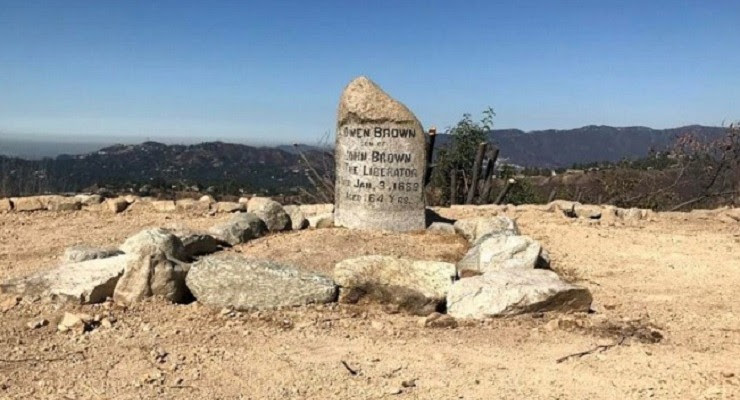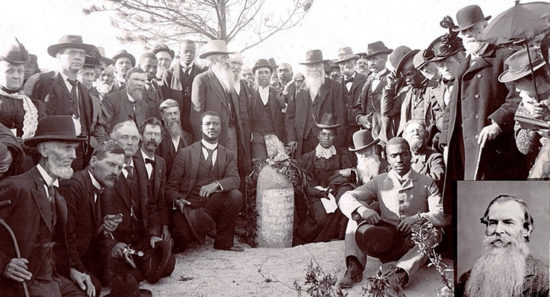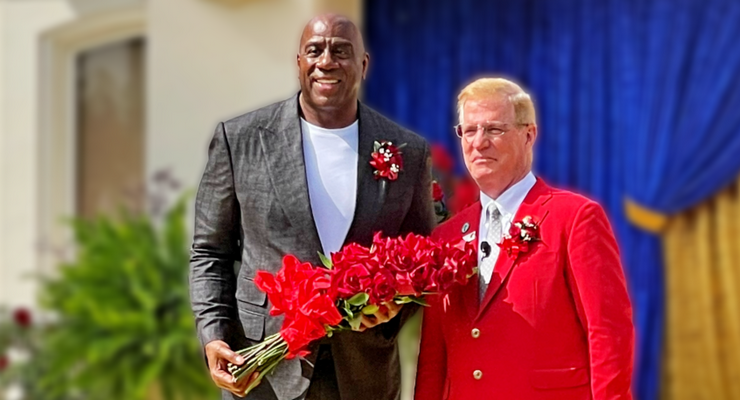
The headstone marking the gravesite of celebrated Altadena resident and Civil War-era abolitionist Owen Brown has been restored to his gravesite at the northern end of Altadena after being missing for 17 years.
Following decades of work by a series of historically-minded organizations, as well as help from the current property owner, the headstone has been restored to its position on a plot of land known as “Little Round Top,” named after the famous Civil War battlefield, north of El Prieto Road, said Los Angeles County Owen Brown Gravesite Committee Chair Michele Zack.
“It’s really wonderful progress,” Zack said. “A lot of people have stepped up to make it happen.”

The property owner has also agreed to turn the property over to a land conservancy, according to Zack.
A small retaining wall was built to fortify the gravesite against erosion, she said. The contractor built it larger and stronger than specified, at no extra cost.
A group of six workers used a wheelbarrow to haul the roughly 500-pound monument to the gravesite, according to Zack.
The L.A. County Owen Brown Gravesite Committee, formed by the L.A. County Board of Supervisors, will continue working to preserve the site, as well as educate the community about its historical significance, she said.
“We’re going to be preserving that open space,” she said.
The committee was narrowly tasked with four objectives, Zack explained.
The first goal of restoring the headstone has now been achieved.
The four-member committee is currently focusing on its other three tasks: Obtaining county historical landmark designation for the site; moving the property into a land conservancy; and providing education about the grave and the Brown family.
Efforts to have the site designated a historical landmark have been ongoing since 1989, Zack said. “I think this time we’re going to be successful.”
The committee plans to work alongside the Pasadena Unified School District to develop a curriculum for students regarding the local area’s Civil War-era history, to include elements such as a video, she said.
The Altadena and Pasadena areas have a rich history related to abolitionism, according to Zack. “We want to bring that into our local classrooms.”
She thanked the current property owner and developer, Tim Cantwell, her colleagues on the Owen Brown Gravesite Committee, and local historian and preservationist Paul Ayers for their dedication to the project.
In addition to allowing the land to be placed into a conservancy, Cantwell offered to advance the cost of replacing the headstone, allowing the project to move forward faster without waiting for county funding to officially come through, Zack said.
“Without developer Tim Cantwell’s cooperation and hard work, such an outcome could not have been achieved,” Altadena Heritage said in a written statement.
In addition to Zack, who represents Altadena Heritage, the committee includes Diane Marcussen, representing the Altadena Town Council; Marietta Kruells, representing Altadena Trails; and John Burton, representing The Meadows neighborhood.
The gravesite has been a source of controversy in the past, with the landowner at the time attempting to prevent access to the site in 2006, before a court declared the public had the right to visit the grave.
The monument went missing in 2004, then was found again in 2012 by a hiker, having apparently been rolled down a hill. Since the headstone’s recovery, preservationists and historians have been working to see it restored to the grave.
Owen Brown was the son of famed abolitionist John Brown, who was hanged after leading the failed 1859 raid on the federal armory at Harpers Ferry, Virginia.
Owen Brown fled following the ill-fated raid and spent two decades as a fugitive.
Despite a $25,000 bounty on his head, he continued working to help escaped slaves transit the underground railroad, according to the Los Angeles Times.
Owen Brown settled in Altadena, following his brother and sister, in the early-1880s. He received a hero’s welcome.
“The family was attracted by our area’s abolitionist, Temperance-minded culture of Union supporters,” according to the statement. “Such significant history in our own backyard has cried out for preservation for more than 100 years.”
Owen Brown died in 1889.
More information on the efforts to preserve Owen Brown’s gravesite is available on Altadena Heritage’s website at altadenaheritage.org/owen-


















